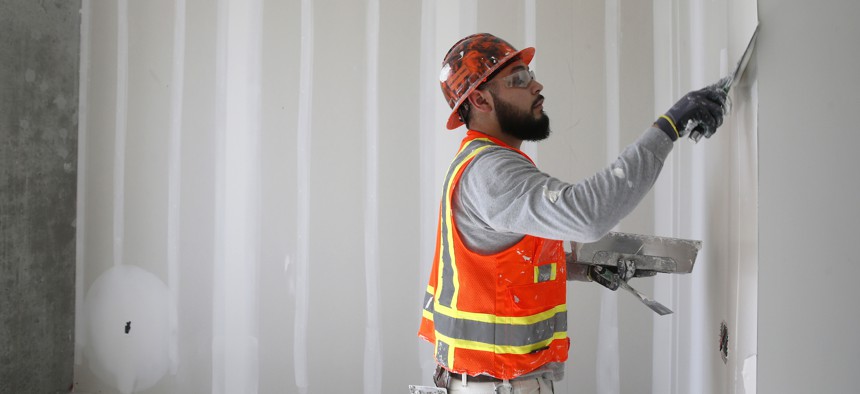How one city is streamlining housing construction

Alonso Gutierrez prepares an apartment for a final coat of paint in a San Francisco apartment building under construction in 2018. Paul Chinn/The San Francisco Chronicle via Getty Images
San Francisco is required by state law to build 82,000 housing units by 2031, but it won’t even come close if the city maintains its current pace. Mayor London Breed hopes that reducing fees and red tape will spur more development.
San Francisco needs to build 82,000 housing units over the next eight years, but is struggling to get even 3,000 units online annually. Mayor London Breed is looking to recently signed legislation deregulating aspects of the construction process to spark new development and get more San Franciscans housed.
High building fees and redundant or even unnecessary policies have choked development in the city, Breed said at Bloomberg Philanthropies’ CityLab conference in Washington, D.C. this week. It can take seven to 10 years for some affordable housing projects to reach completion, a challenge in a city struggling to get more housing online faster to mitigate skyrocketing housing costs.
“We need to make sure that we get out of our own way when it comes to housing,” Breed said.
To streamline construction, city supervisors in July slashed building impact fees—charges that developers pay to help fund city services—by 33% for the next three years. They also reduced the number of affordable units developers are required to include in a project, though exactly how much depends on the project’s location and where in the construction pipeline it is.
It’s too soon to know how these changes affect development, but there’s still room to simplify review processes. Like most cities, San Francisco has rules about what kinds of buildings can be built in certain areas, including regulations for building height and setback. With all these requirements already outlined for developers, it doesn’t make sense for the city to slow the process with lengthy permitting reviews, Breed said.
“These should be over-the-counter permits because most of the time people are following the laws that are already on the books,” she said.
The levers local officials can pull to spur development are few but mighty. Allowing large multifamily buildings to be constructed in the hearts of cities, eliminating minimum lot size requirements and permitting manufactured housing in more places are among the most powerful decisions local governments can make, said Emily Hamilton, director of the Urbanity Project at the Mercatus Center at George Mason University.
These approaches, she said, “are solutions that have proven to be able to deliver more and less-expensive housing at scale.”
Community buy-in continues to be a challenge, Breed said. Opponents of new development can stall construction through processes like requesting unnecessary environmental reviews.
But a state law is helping San Francisco get around some of those challenges. Last week, Gov. Gavin Newsom signed a bill that extends and expands 2017 legislation that streamlined housing processes. SB 35, which was set to expire in 2026 but is now in force until 2036, requires cities to quickly approve multifamily projects that meet standard development parameters. It has helped create 18,000 affordable units over the last five years.
“It's been very tough to really deregulate some of the requirements around housing, and it's really why the state changes put us in a better position,” Breed said. With laws like SB35, cities have more ways to push forward housing projects that face local opposition.
The White House has also encouraged cities to reconsider their housing construction regulations. In July, the Biden administration announced a new $85 million program that would help communities identify and remove obstacles to housing development.
Federal interest in housing deregulation is growing, Hamilton said, and that could be both a blessing and a curse. Increased awareness at the federal level may mean more resources for localities addressing affordable housing challenges, but it also risks turning housing into a partisan issue at the federal level.
“I would like to see some of this state and local experimentation that we've seen really accelerating over the past decade have a little bit more chance to play out,” she said at Thursday’s event.
Despite the daunting challenges, there are reasons to be optimistic about the future of housing deregulation, Breed said. Residents are coming to terms with how high rents and mortgage payments are forcing longtime residents out of the city, and a new generation of housing advocates are more open to policies that encourage development.
“They're pushing for an opportunity for future generations to have access to housing in places they grew up in,” Breed said.






